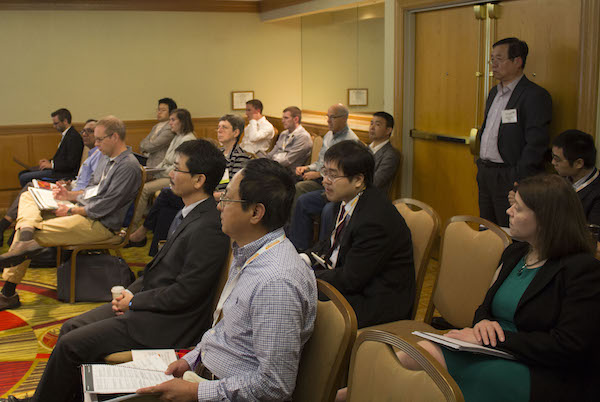
[Image above] An attentive audience at a symposium session at HTCMC-GFMAT. Credit: ACerS
Student report by Yin Liu, Alfred University
Several sessions on optical materials were held during the 9th International Conference on High Temperature Ceramic Matrix Composites, which generally covers topics on advanced materials and technologies for electro-optical and medical applications. Rare earth-related phosphors and laser optics have been a longtime major focus in this field as well.
We have just passed 2015, known as “the year of light,” and we are embracing some new technologies stemming directly or indirectly from optics and optical devices, such as flexible displays, high resolution LEDs, etc. I am excited to see the inclusion of several sessions on optical materials in this year’s HTCMC, GFMAT joint conference. The scope of the technical talks covered the range from single crystal to polycrystalline ceramic materials. Some of the conventional topics, such as rare-earth energy transition mechanisms and host selection, were also well discussed. However, I am more impressed by some new ideas and novel techniques shared by the presenters. Professor T. Takeda from NIMS, Japan, introduced a new idea of screening efficient phosphors by single particle luminescence diagnosis. From my own perspective, this method could guide researchers to discover new hosts with higher quantum efficiency and tunable luminescence.
One problem that researchers always encounter is the phase purity issue for some phosphorous solids, and people sometimes are stuck with the task to synthesize a certain phase. However, the “undesired” phases during the course of experiments might be “shiny” and also deserves investigation, because we have thousands of phase diagrams and many more unstudied solids that might serve as potential hosts for rare-earth activators and color centers.
The single particle luminescence diagnosis could concern all the particles with various phases at the same level and prevent researchers from omitting any “shiny” particles that emit the desired or “exotic” spectrum. Another interesting topic is how to combine the merits of glass or single crystal with polycrystalline.
Professor Allix from CNRS in France introduced the fabrication of transparent ceramics from glass crystallization. It has been well known that the transparent ceramics impose great difficulties for synthesizing. However, inspired by the easiness of densification of glass microspheres and high transparency of glass-ceramics, transparent ceramics could be fabricated from amorphous glass rather than consolidating solid particles.
I am currently a Ph.D. candidate from New York State College of Ceramics at Alfred University. My research focuses on sintering of transparent ceramics and related grain boundary behaviors. I will give a talk on converting polycrystalline materials into single crystals via solid-state method during this conference. In this research, my goal is to obtain larger non-oxide crystals by triggering single crystal growth into a polycrystalline matrix so that part of the polycrystalline could be “converted” to single crystal simply by heat treatment, which is more cost-effective than the conventional crystal growth method.
Through attending the first several days’ technical sessions, I came up with some new thoughts on the optical materials after associating all the key points from the talks with my own research field. During the past few decades, both the synthesis methods and experimental techniques have evolved into interdisciplinary examination and development, where researchers began to think about the interrelationships between physics and chemistry, scale and properties, and among different material substances.
For optical materials, one of the current trends is to bridge the gap between ceramics, glass, and single crystals. Each field could borrow something useful from another, while eventually a common ground could be reached. What glass-ceramic tells us is that we can utilize the viscous flow of glass to easily achieve full densification, which is always a difficult task for pure ceramics. For the single crystal-ceramic research, we still need to further explore how the single crystal or a single grain grows and what makes complete ceramic conversion so difficult.
From attending this conference, I at least got some new ideas from single crystal, phosphor, and how to make good optical materials. So it’s time for me to digest my new thoughts and let them become solid progress for my future research.
